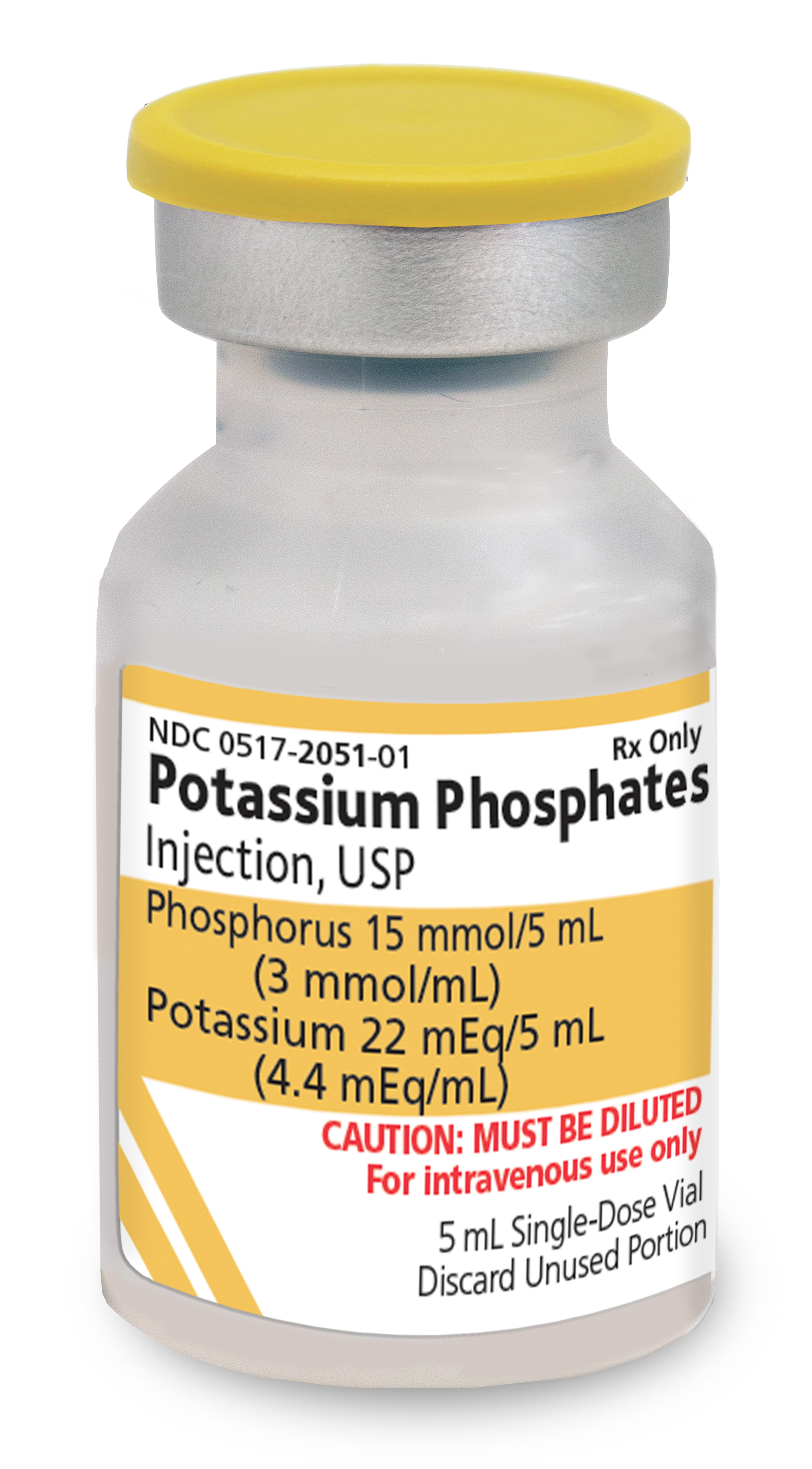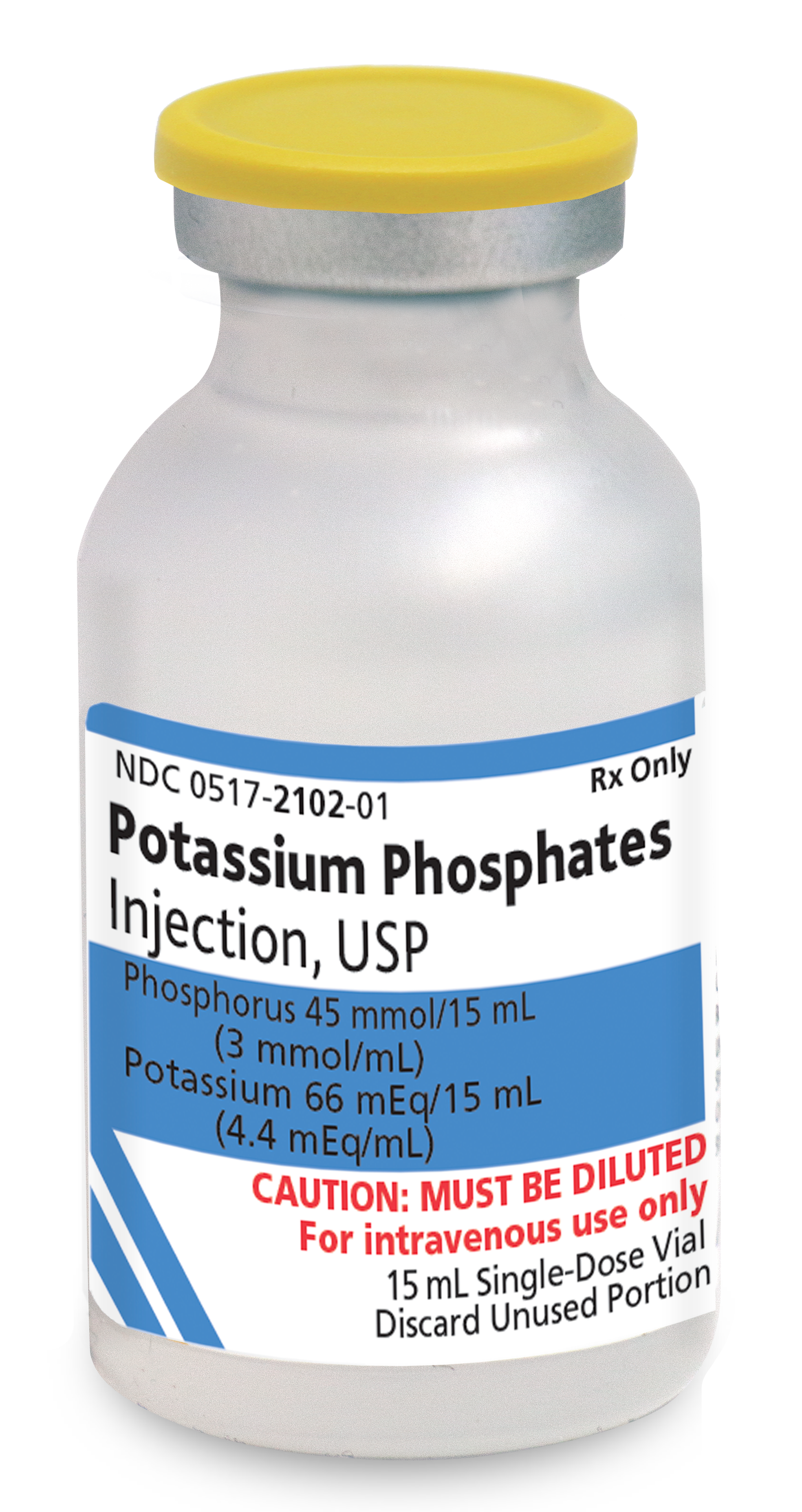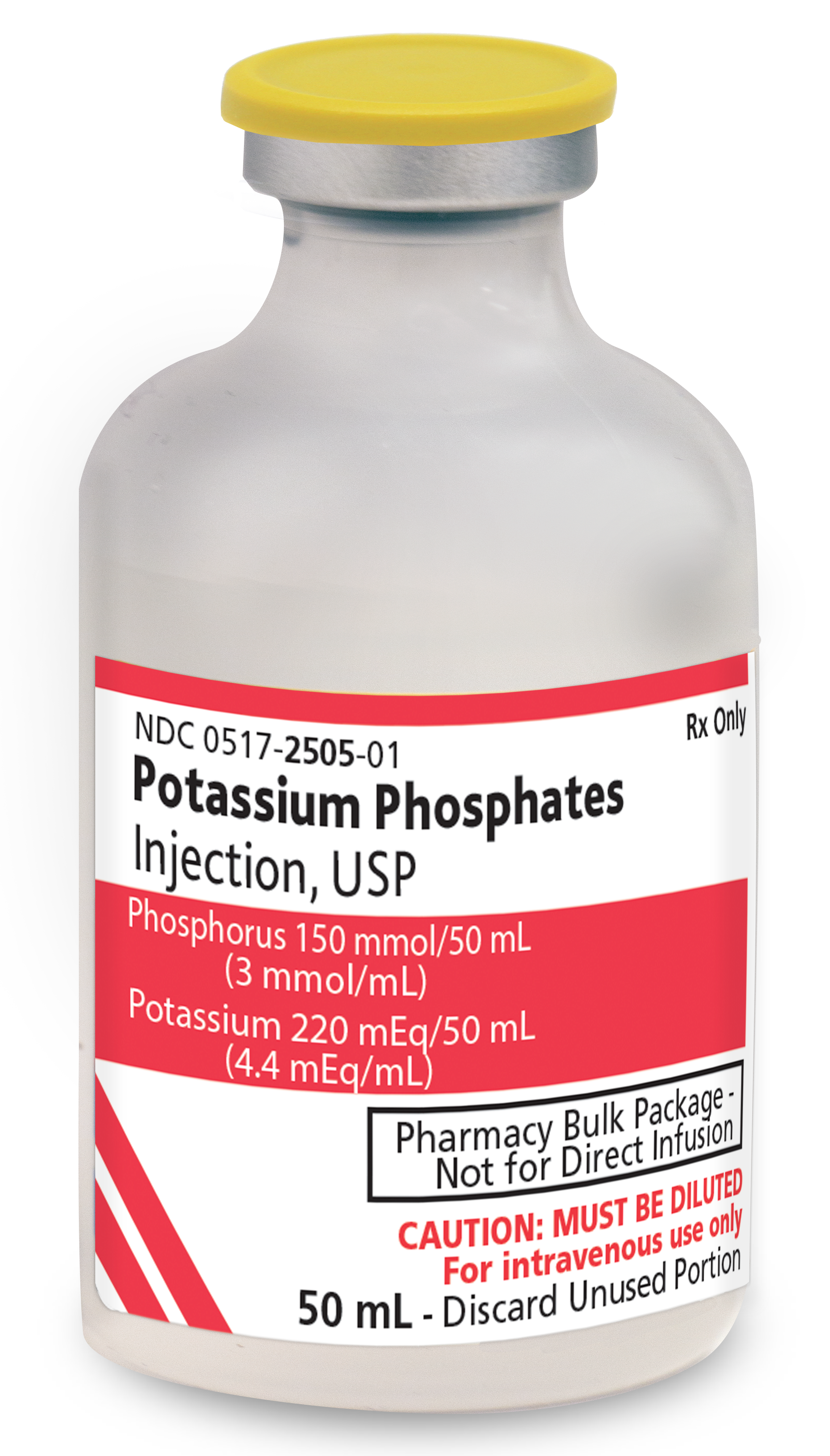Contact Us
By clicking Submit, you confirm that you accept our Privacy Policy and that you agree to your personal contact information being used to contact you and added to our database. If at any time you wish your personal information to be removed from the American Regent® database, please submit a message request to corpcommunications@americanregent.com.
CONTRAINDICATIONS
Potassium Phosphates Injection is contraindicated in patients with: hyperkalemia; hyperphosphatemia; hypercalcemia or significant hypocalcemia; severe renal impairment (eGFR less than 30 mL/min/1.73m2) or end-stage renal disease.
WARNINGS AND PRECAUTIONS
Serious Cardiac Adverse Reactions with Undiluted, Bolus, or Rapid Intravenous Administration: Intravenous administration of potassium phosphates to correct hypophosphatemia in single doses of phosphorus 50 mmol and greater and/or at rapid infusion rates (over 1 to 3 hours) in intravenous fluids has resulted in death, cardiac arrest, cardiac arrhythmia (including QT prolongation), hyperkalemia, hyperphosphatemia, and seizures. In addition, inappropriate intravenous administration of undiluted or insufficiently diluted potassium phosphates as a rapid “IV push” has resulted in cardiac arrest, cardiac arrhythmias, hypotension, and death. Administer only after dilution or admixing; do not exceed the recommended infusion rate. Continuous electrocardiographic (ECG) monitoring may be needed during infusion.
Pulmonary Embolism due to Pulmonary Vascular Precipitates: Pulmonary vascular emboli and pulmonary distress related to precipitates in the pulmonary vasculature have been described in patients receiving admixed products containing calcium and phosphate or parenteral nutrition. If signs of pulmonary distress occur, stop the infusion and initiate a medical evaluation.
Hyperkalemia: Potassium Phosphates Injection may increase the risk of hyperkalemia, including life-threatening cardiac events, especially when administered in excessive doses, undiluted, or by rapid intravenous infusion. There is an increased risk of hyperkalemia in patients with severe renal impairment, end stage renal disease, severe adrenal insufficiency, and in patients treated concurrently with other drugs that cause or increase the risk of hyperkalemia. Patients with cardiac disease may be more susceptible. Do not exceed the maximum daily amount of potassium or the recommended infusion rate. Continuous ECG monitoring may be needed during infusion.
Hyperphosphatemia and Hypocalcemia: Hyperphosphatemia can occur with intravenous administration of potassium phosphates, especially in patients with renal impairment. Hyperphosphatemia can cause the formation of insoluble calcium phosphorus products with consequent hypocalcemia, neurological irritability with tetany, nephrocalcinosis with acute kidney injury, and, more rarely, cardiac irritability with arrhythmias. Monitor serum phosphorus and calcium concentrations during and following infusion.
Aluminum Toxicity: Potassium Phosphates Injection contains aluminum that may be toxic. Patients with renal impairment, including preterm infants, can accumulate aluminum at levels associated with central nervous system and bone toxicity.
Hypomagnesemia: Reported in patients with hypercalcemia and diabetic ketoacidosis. Monitor serum magnesium concentrations during treatment.
Vein Damage and Thrombosis: Potassium Phosphates Injection must be diluted and administered in intravenous fluids or used as an admixture in parenteral nutrition. It is not for direct intravenous infusion. The infusion of hypertonic solutions into a peripheral vein may result in vein irritation, vein damage, and/or thrombosis.
Laboratory Monitoring: Monitor serum phosphorus, potassium, calcium, and magnesium concentrations during treatment.
ADVERSE REACTIONS
Adverse reactions include hyperkalemia, hyperphosphatemia, hypocalcemia, and hypomagnesemia.
The following clinically significant adverse reactions are described elsewhere in the labeling: Aluminum Toxicity; Hypomagnesemia; Vein Damage and Thrombosis
DRUG INTERACTIONS
Other Products that Increase Serum Potassium - Administration of Potassium Phosphates Injection to patients treated concurrently or recently with products that increase serum potassium increases the risk of severe and potentially fatal hyperkalemia, in particular, in the presence of other risk factors for hyperkalemia. Avoid use of Potassium Phosphates Injection in patients receiving such products. If use cannot be avoided, closely monitor serum potassium concentrations.
USES IN SPECIFIC POPULATIONS
Lactation - Phosphorus and potassium are present in human milk. Administration of the recommended dose of Potassium Phosphates Injection is not expected to cause harm to a breastfed infant. There is no information on the effects of potassium phosphates on milk production. The development and health benefits of breastfeeding should be considered along with the mother’s clinical need for Potassium Phosphates Injection and any potential adverse effects on the breastfed child or from the underlying maternal condition.
Pediatric Use - Because of immature renal function, preterm infants receiving prolonged parenteral nutrition treatment with Potassium Phosphates Injection may be at higher risk of aluminum toxicity.
Geriatric Use - Dose selection of Potassium Phosphates Injection for an elderly patient should be cautious, starting at the low end of the dosing range. It may be useful to monitor renal function during treatment.
Renal Impairment - Potassium and phosphorus are known to be substantially excreted by the kidney and the risk of adverse reactions to Potassium Phosphates Injection may be greater in patients with impaired renal function. Use is contraindicated due to the risk of hyperkalemia in patients with severe renal impairment (eGFR less than 30 mL/min/1.73 m2) or end-stage renal disease. In patients with moderate renal impairment (eGFR ≥ 30 mL/min/1.73 m2 to < 60 mL/min/1.73 m2), start at the low end of the dosage range and monitor serum potassium, phosphorus, calcium, and magnesium concentrations.
OVERDOSAGE
Hyperphosphatemia - Administration of excessive doses of intravenous potassium phosphates in intravenous fluids and/or at rapid infusion rates has resulted in death, cardiac arrest, cardiac arrhythmia (including QT prolongation), hyperkalemia, hyperphosphatemia, seizures, and tetany.
Hyperphosphatemia is particularly a risk in patients with renal failure. Hyperphosphatemia leads in turn to hypocalcemia, which may be severe, and to ectopic calcification, particularly in patients with initial hypercalcemia. Tissue calcification may cause hypotension and organ damage and result in acute renal failure.
Hyperkalemia - Excessive administration of phosphates given as potassium salts may also cause hyperkalemia. Manifestations of hyperkalemia include: disturbances in cardiac conduction and arrhythmias, including bradycardia, heart block, asystole, ventricular tachycardia, ventricular fibrillation; hypotension; muscle weakness including paresthesia, muscular and respiratory paralysis.
Management- In the event of overdosage, discontinue infusions containing potassium phosphates immediately and institute general supportive measures, including ECG monitoring, laboratory monitoring, and correction of serum electrolyte concentrations, especially potassium, phosphorus, calcium, and magnesium.
INDICATIONS AND USAGE
Potassium Phosphates Injection is indicated as a source of phosphorus:
- in intravenous fluids to correct hypophosphatemia in adults and pediatric patients when oral or enteral replacement is not possible, insufficient, or contraindicated.
- for parenteral nutrition in adults and pediatric patients when oral or enteral nutrition is not possible, insufficient, or contraindicated.
For additional safety information, please see Full Prescribing Information.
You are encouraged to report adverse drug events to American Regent, Inc. at 1-800-734-9236 or to the FDA by visiting www.fda.gov/medwatch or calling 1-800-FDA-1088.
REF-2383 2/2025


